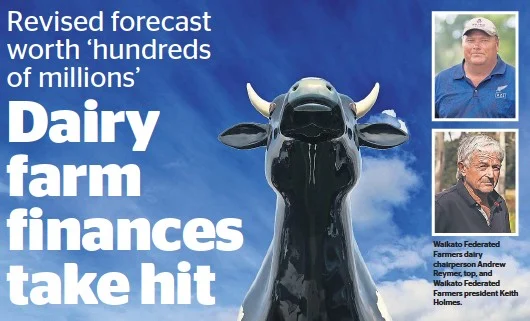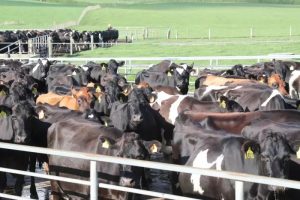
Revised forecast worth ‘hundreds of millions’
The latest Fonterra milk price forecast, down $1 a kg of milk solids, is expected to knock hundreds of millions of dollars off Waikato dairy farmers’ incomes this season compared to an earlier forecast.
It comes at a time of significantly higher costs and Waikato Federated Farmers dairy section chairperson Andrew Reymer said the flow-on effects would be “absolutely massive”.
Dairy co-op Fonterra announced it had reduced the 2023-24 season forecast farmgate milk price range from $7.25-$8.75 per kg of milk solids down to $6.25-$7.75. The mid-point drops from $8 to $7. This compares to a forecast mid-point of $8.20 for last season. The final Fonterra milk price for 2022-23 won’t be confirmed until next month. Fonterra said the forecast drop reflected ongoing reduced demand for whole milk powder in China.
Ōhaupō-based Reymer said Waikato dairy farms produced on average about 100,000 to 120,000 kg/ms, so $1 a kg represented around $100,000 to $120,000 less in gross income per season. He estimated 3000-plus Fonterra suppliers in the wider Waikato and that would likely mean well over $300 million less in regional co-op payout compared to the earlier forecast: “That’s a big chunk of money.”
He said cutting $100,000-$120,000 off average income would reduce scope for
“discretionary” farm spending significantly. “The non-essential suppliers of farmers will get hit the worst.”
Fonterra responded with an improved dividend to offset some of the pain. Chief executive Miles Hurrell said it expects to pay a full-year dividend at the top end of dividend policy. It also plans to pay shareholders a special 50c dividend after completing its overseas asset sales programme.
Craigs Investment Partners investment adviser Peter McIntyre said: “Hopefully, this will be some form of revenue respite for Fonterra shareholders”
Dairy NZ statistics for 2021-22 also bear out the scale of the issue, indicating 3051 herds in the region supplying various dairy operations, with average production of 131,979 kg/ms per herd. This included Thames-Coromandel, Hauraki, Waikato district, Matamata-Piako, Hamilton, Waipa, Ōtorohanga and South Waikato.
Waikato Federated Farmers president Keith Holmes agreed the projected cut to forecast incomes was deeply worrying.
The community would also be affected because each $1 a dairy farmer spent had a “multiplier” effect on total spending in the economy. “Billions” worth of cuts in total spending could be the result of the forecast lower payout.
Suppliers other than Fonterra would also be affected by the downturn. “Dairy farmers of whatever company will have the same sort of reduction,” Holmes said. “This isn’t just a shower, it’s an iceberg coming through.”
Some could have a cash-flow crisis. It was expected a very small percentage of farms would trade at a profit but 70%-80% could be running at a loss, he said.
Commenting nationally, industry body Dairy NZ said the decreased forecast alongside higher costs would be a shock. The organisation was revising forecasts for total net cash income for dairy farmers for the season, and it noted that if costs stay high there is a risk of “significant cash loss for many dairy farmers”.
Farmers should look at where spending can be reduced and pause non-essential capital projects, Dairy NZ said.
Waikato Rural Support Trust chairperson Neil Bateup said the decline in forecast payout required action. Bateup recommended farmers proactively talk to their banks and accountants: “It’s always better to have a plan than not.”
Dairy NZ said it was positive that the sector’s debt had dropped $5.4 billion since 2018. “But obviously there will be a range of debt levels,” said Bateup.
Dairy NZ’s farm performance manager Sarah Speight said at least recent signals meant the latest reduction wasn’t such a surprise and she expected things to improve in the not-too-distant future.
























